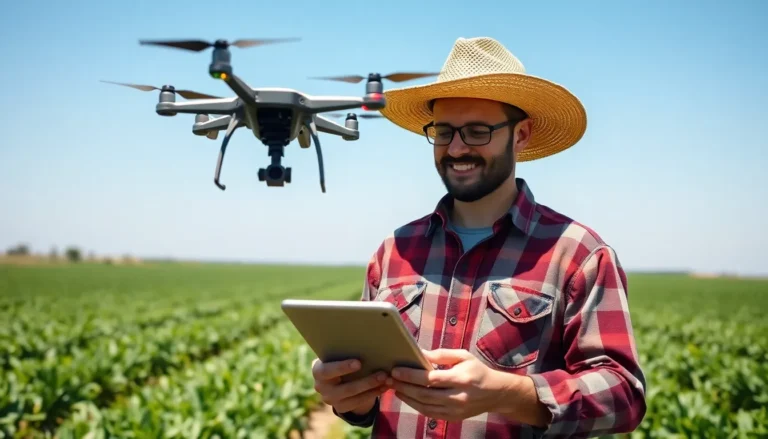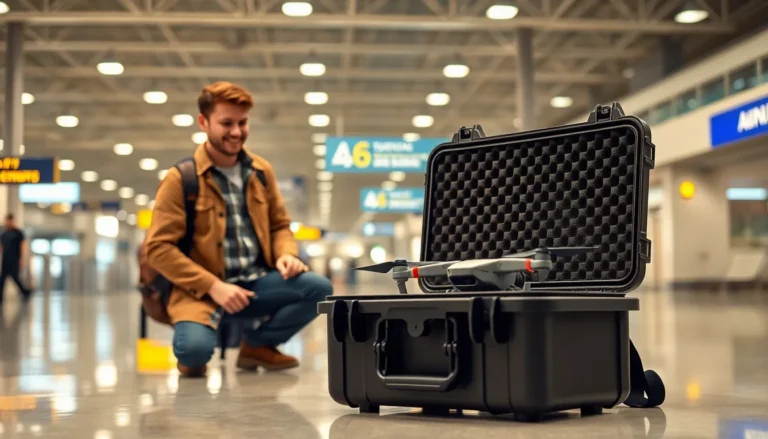In a twist that sounds like a plot straight out of a spy thriller, German military officials are scratching their heads over a series of mysterious drone sightings. These suspected Russian drones have taken a detour over a military base, raising eyebrows and a few chuckles among defense analysts. Is it a case of high-tech reconnaissance or just a really ambitious tourist trying to snap the perfect aerial selfie?
As tensions simmer in Europe, this unexpected aerial visit has sparked investigations that could rival any detective novel. With potential implications for national security and international relations, the stakes are high. So buckle up as we dive into this intriguing scenario where drones, diplomacy, and a dash of humor collide in the skies above Germany.
Table of Contents
ToggleOverview of the Incident
Recent drone sightings above a German military base have raised significant concerns regarding national security. These drones are suspected to be of Russian origin, prompting immediate investigations. Defense analysts express worry about the possible implications for international relations as tensions escalate in Europe.
Local authorities reported multiple instances of unidentified drones flying over the area. Investigators aim to determine the purpose behind these flights, whether it’s espionage or something less sinister. Reports of unusual aircraft began circulating in late September 2023, piquing the interest of military officials.
The German military swiftly responded by increasing surveillance in the vicinity. They’ve implemented measures to track unidentified aerial vehicles more effectively. Information collected during the investigations will likely inform broader defense strategies within NATO.
Coordination with international partners adds another layer to this situation. Intelligence sharing may lead to insights about the drones’ origins. If linked to Russian activities, this development could exacerbate ongoing geopolitical tensions.
Witness accounts describe the drones as small, agile, and capable of evading detection. Some experts speculate their purpose might focus on reconnaissance or photography. Additionally, they highlight the growing sophistication of drone technology and the challenges it poses for traditional military operations.
Each sighting emphasizes the necessity for enhanced airspace security measures. Authorities anticipate further developments as investigations progress. Observers remain attentive to how this incident might affect Germany’s foreign policy and its posture within NATO.
Background on Russian Drones
Russian drones, increasingly common in military contexts, have drawn attention due to recent sightings over a German military base. Investigators are focusing on these unmanned aerial systems’ capabilities and implications.
Types of Drones Used
Various types of Russian drones may operate in reconnaissance roles. The Orlan-10 serves as a popular model, equipped with surveillance technology for collecting intelligence. Another variant, the Forpost, mimics Israeli designs and is used for battlefield monitoring. Both types exhibit features like enhanced maneuverability and low radar visibility. Smaller drones, like the ZALA 421-16E, support covert operations and real-time data transmission. Analysts emphasize that the ability of these drones to evade detection adds a layer of complexity to monitoring airspace.
The Role of Drones in Military Operations
Drones play significant roles in contemporary military operations. They enable surveillance missions, allowing forces to gather intelligence without exposing personnel to risk. Strategic advantages come from their ability to conduct long-range reconnaissance, revealing enemy movements and positions. Additionally, drones contribute to electronic warfare, disrupting communications and targeting enemy assets. Use of drones can enhance situational awareness, leading to informed decision-making. Military tactics now increasingly incorporate unmanned systems, transforming the landscape of modern warfare.
Investigation Details
Investigations into the suspected Russian drones have unveiled critical insights as authorities respond to the alarming sightings over the German military base. Investigative efforts encompass detailed timelines and reliance on various sources of information.
Timeline of Events
Multiple drone sightings began in early September 2023. Local authorities received reports almost daily, with one notable incident occurring on September 15, where a drone was spotted at an altitude of approximately 2,000 feet. On September 20, defense analysts connected specific sightings to unusual activities in nearby urban areas. By September 25, intelligence agencies heightened surveillance measures in response to escalating tensions. Coordination with NATO partners also started, emphasizing the urgency of the situation. Efforts to monitor airspace intensified in early October, allowing military officials to track drone activities systematically.
Sources of Information
Authorities gathered information from various channels to understand the drone incidents comprehensively. Witnesses, including military personnel and local residents, provided crucial reports detailing descriptions of the drones and their movements. Additionally, intelligence assessments evaluated satellite imagery and radar data to verify sightings. Collaboration with international partners, especially intelligence-sharing initiatives, facilitated a broader context for understanding these airborne intrusions. Defense analysts consulted prior incidents involving Russian drones to establish patterns and potential motives for the reconnaissance activities. Research from defense think tanks contributed further analysis, enhancing the investigation’s status.
Implications for German Security
The drone sightings raise significant concerns regarding national security. Potential threats manifest in various forms, directly impacting Germany’s defense posture and regional stability.
Potential Threats
Surveillance by suspected Russian drones threatens military installations. Analysts emphasize the risk of intelligence gathering that could inform enemy tactics. Increased aerial reconnaissance may compromise sensitive operations. Authorities consider the possibility of these drones facilitating cyber-attacks or other military interventions. Heightened activity near military bases signals an escalation in geopolitical tensions. Experts warn that a lack of immediate response could embolden further incursions.
Response from German Authorities
German authorities have promptly intensified counter-drone operations. Enhanced surveillance protocols involve advanced radar and monitoring systems. Intelligence sharing with NATO partners plays a crucial role in addressing the evolving threat landscape. Military officials now conduct regular assessments to better understand drone capabilities and intentions. Increased presence of military personnel helps deter potential incursions. Coordination with local law enforcement ensures a comprehensive response strategy against unauthorized aerial activities.
International Reactions
International responses to the suspected Russian drones flying over a German military base reflect growing concerns in Europe about security and military tactics.
Reactions from NATO
NATO officials have expressed alarm over the sightings. Heightened surveillance in European airspace has become a priority for the alliance. Many member states are collaborating to assess the implications of these drone activities. Intelligence sharing among NATO nations aims to gather comprehensive insights about reconnaissance patterns. Germany’s proactive approach has prompted discussions about strengthening collective defense measures. The potential for increased drone activity in nearby regions raises additional security questions for member nations.
Global Concerns about Drone Warfare
Global analysts emphasize the shifting landscape of modern warfare. The incidents underscore the evolving use of drones in military operations worldwide. Nations are realizing that these aerial vehicles pose significant threats to national security. Regions facing heightened tensions are particularly concerned about drones’ roles in surveillance and potential attacks. Cybersecurity implications related to drone operations capture the attention of military strategists. The ongoing investigations into the drones serve as a crucial reminder of the need for robust airspace regulations and counter-drone technologies.
The investigation into the suspected Russian drones over the German military base underscores the growing complexities of modern security challenges. As authorities enhance surveillance and collaborate with NATO partners, the implications for national defense strategies become increasingly clear.
These incidents highlight the urgent need for improved airspace security measures and the potential risks posed by advanced drone technology. With tensions rising in Europe, the proactive response from German officials reflects a commitment to safeguarding national interests.
The evolving landscape of military operations demands continuous vigilance and adaptation, ensuring that nations remain prepared for any unforeseen threats.





